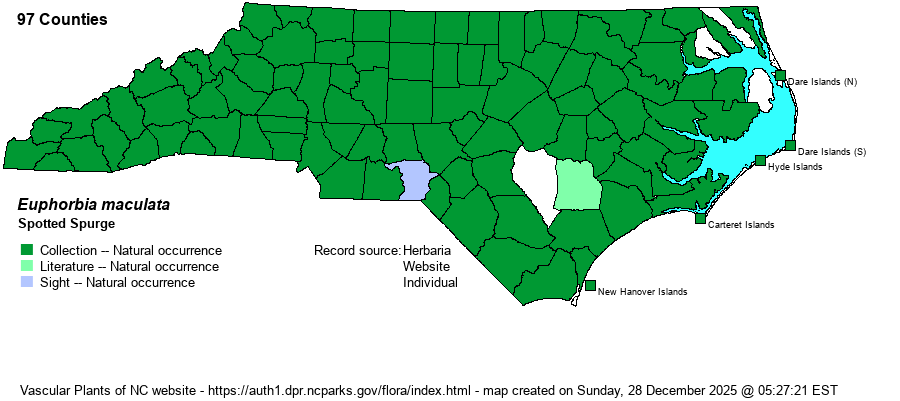| Author | L. | |
| Distribution | Throughout the state; certain to be found in every county.
Que. to ND, south to FL and TX; introduced nearly worldwide. | |
| Abundance | Common to very common, and sometimes abundant. | |
| Habitat | Spotted Spurge is a highly successful "native weed". Its original habitat is unknown, but today it thrives in all sorts of disturbed situations, usually in sandy or gravelly soil: roadsides, parking lots, powerlines, clearings, vacant lots, sidewalk cracks, trail sides, flower beds, gardens, lawns, fields, cropfields, highway medians, etc. | |
| Phenology | Flowering and fruiting practically throughout the year. | |
| Identification | Spotted Spurge is one of several prostrate, mat-forming species in NC. The leaves may or may not have a red-purple central blotch, but if they do, it quickly separates this species from other prostrate ones. Unlike E. bombensis, E. cordifolia, and E. polygonifolia, it has short hairs on the upper stems and branches (vs. glabrous) and toothed leaf margins (vs. smooth). The alien E. prostrata, rare in the state, differs in having stem pubescence only on one side (vs. all around) and leaves only twice as long as wide (vs. 3 times); that exotic species has leaves more rounded to circular and not as oblong (often with parallel sides) as the native species. | |
| Taxonomic Comments | Synonyms include E. supina and Chamaesyce maculata. Note that RAB (1968) named most of this species as E. supina. The E. maculata in RAB (1968) is mostly now named as E. nutans; that is an erect species.
| |
| Other Common Name(s) | Milk Purslane, Spotted Sandmat | |
| State Rank | S5 | |
| Global Rank | G5? | |
| State Status | | |
| US Status | | |
| USACE-agcp | FACU link |
| USACE-emp | FACU link |

